Focusing on Scenario Implementation, Shaping Intelligent Connectivity. The Harmony Ecosystem Conference 2025 was grandly inaugurated on August 30 at the Shenzhen Convention and Exhibition Center in Futian. This year's conference, themed "New Scenario・New Experience," was hosted by the Global Intelligent IoT Alliance (GIIC) and organized by Harmony Ecosystem Services (Shenzhen) Co., Ltd. It delved into how the Harmony ecosystem can empower various industries.
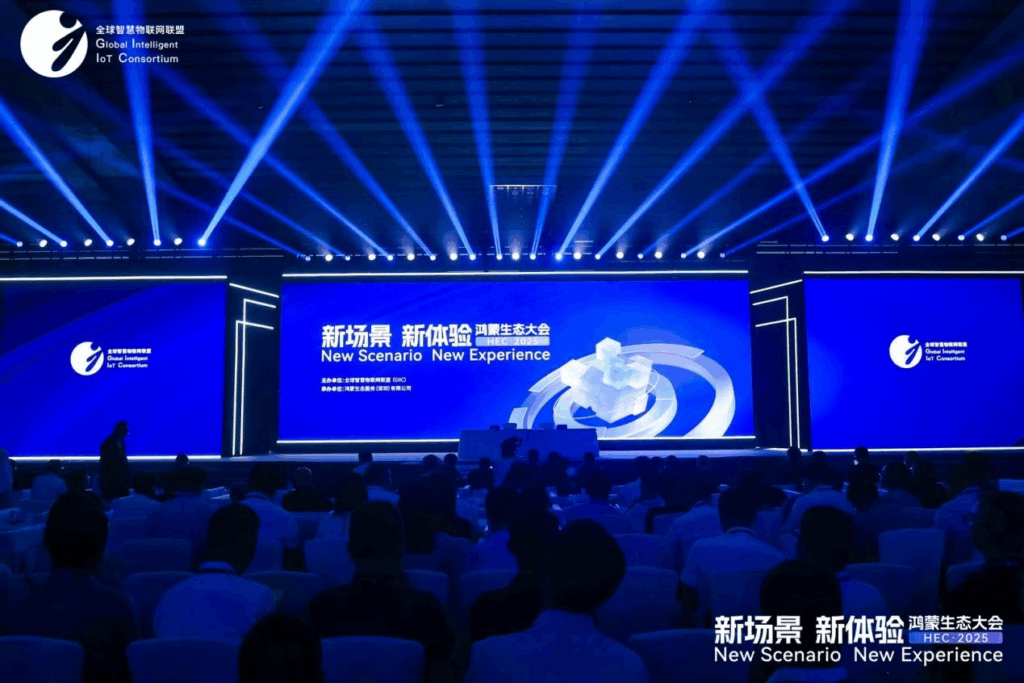
The two-day event was rich and diverse, covering a main forum, sub-forums, an ecosystem exhibition area, signing ceremonies, and the release of a white paper. It comprehensively showcased the advanced progress and future vision of the Harmony ecosystem in technological innovation, industrial integration, and ecosystem co-construction. The conference attracted over 3,000 industry experts, entrepreneurs, developers, ecosystem partners, and government leaders from around the world. The collision and integration of diverse forces not only confirmed the global influence of the Harmony ecosystem but also demonstrated an open and inclusive posture, actively participating in and promoting the reconstruction of the global innovation landscape.
As the annual grand event of the Harmony ecosystem industry, the Harmony Ecosystem Conference aims to build a global communication and cooperation platform for Harmony ecosystem partners. It provides opportunities for cooperation, exchange, and display among numerous ecosystem partners and institutions, explores development and cooperation opportunities for the Harmony ecosystem, showcases leading cooperation results, and stimulates collaborative innovation across the entire industry chain. Compared to the inaugural conference in 2024 with the theme "New Ecosystem・New Opportunitie," this year's conference, themed "New Scenario・New Experience," clearly reflects the significant progress of the Harmony ecosystem, shifting from the initial construction of the ecosystem framework to the in-depth implementation of actual scenarios.
Part.1
Leaders' Speeches: Visionary Blueprint Drawing
The conference officially kicked off with the speech by Wang Jiangping, a member of the National Committee of the Chinese People's Political Consultative Conference and Director of the Electronic Technology Committee of the Ministry of Industry and Information Technology. He pointed out that the Harmony operating system is an important achievement in the field of basic software in China. Its open-source co-construction ecosystem model has brought a new development path to the current highly concentrated operating system market. He fully affirmed the achievements of Harmony in the field of intelligent connectivity of all things, while also pointing out that it still faces challenges in application ecosystem, industry solutions, open-source collaboration, and talent cultivation. He called on all parties to adhere to innovation-driven development, deepen open-source co-construction, expand scenario applications, and strengthen talent supply to jointly promote the construction of the Harmony ecosystem.
Part.2
Industry Leaders' Speeches: Perceiving Trends and Clarifying Directions
In the session of industry leaders' speeches, Huawei's rotating chairman Xu Zhijun delivered a keynote speech titled "Together, Making Harmony More Wonderful," which brought the atmosphere of the venue to a climax. Xu Zhijun said that currently, leading Internet applications have been adapted to Harmony, and medium and long-tail applications are also joining in successively. The Harmony ecosystem is basically functional. He especially thanked Internet partners represented by Tencent, Alibaba, ByteDance, Meituan, JD.com, Kingsoft Software, China Railway Group (Railway 12306), Xiaohongshu, Bilibili, Baidu, China Air Transport Information Corporation (umetrip), Ctrip, Tongcheng Travel, Qunar, 58.com, Sina, Sohu, etc., as well as government and enterprise partners such as WeChat for Business, DingTalk, Feishu, Panwei, BlueKing, BlueTrust, CloudHome, Yonyou, Inspur, etc., for their support to the Harmony ecosystem, and pointed out that the success of the Harmony ecosystem is a world-class challenge. Xu Zhijun also put forward five initiatives for building the Harmony ecosystem and creating new Harmony experiences together with all sectors of society.
He said that as a pioneer and trailblazer of the Harmony ecosystem, Huawei calls on ecosystem partners to join hands and make Harmony more wonderful together!
Subsequently, Gao Tongqing, Chairman of GTI and Deputy Director of the Science and Technology Committee of China Mobile, delivered a speech titled "New Opportunities for Intelligent Industry Development in the AI Era." He pointed out that in the AI era, the intelligent terminal industry shows trends of intelligence, integration, and scenario-based development. OpenHarmony, with its advantages of a unified digital foundation and distributed architecture, will become a key foundation for promoting the digital and intelligent transformation of the industry. He called on partners from upstream and downstream of the industry chain to join hands to define a new paradigm of industrial development characterized by "joint platform construction, value co-creation, resource sharing, and industry win-win." Together, they should create high-quality standards, strict certification systems, and rich tool resources, explore new scenarios, products, and solutions, and achieve a leap from technological open-source to ecosystem co-construction. He proposed that in the future, OpenHarmony should focus on four new directions: mobile phones, desktops, vehicles, and embodied intelligence, to output new productive forces for industry digitalization and contribute wisdom and solutions to global digitalization.
Yu Xiaohui, President of the China Academy of Information and Communications Technology, in his speech titled "Reflections on the Development of Terminal Operating Systems in the 'Artificial Intelligence+' Era," focused on the reshaping, challenges, and development paths of artificial intelligence for terminals and operating systems. He pointed out that the integration and application of large models in terminals are gradually deepening, evolving from the application layer to system-level and ecosystem-level artificial intelligence. Led by the system-level integration of operating systems and artificial intelligence systems, through the deep integration of the entire stack of "software, hardware, computing, terminals, and cloud," terminal operating systems will transform from "interconnection hubs" to "intelligent centers." Artificial intelligence is triggering a second revolution in terminal intelligence and accelerating the transformation and reshaping of application ecosystems. Yu Xiaohui fully affirmed the practice of Harmony in the integration of AI and operating systems and called for the industry to jointly build an open and collaborative ecosystem to help achieve a leading position in the global intelligent process.
Part.3
Memorandum of Understanding Signing Ceremony: Collaborative Construction of New Foundations
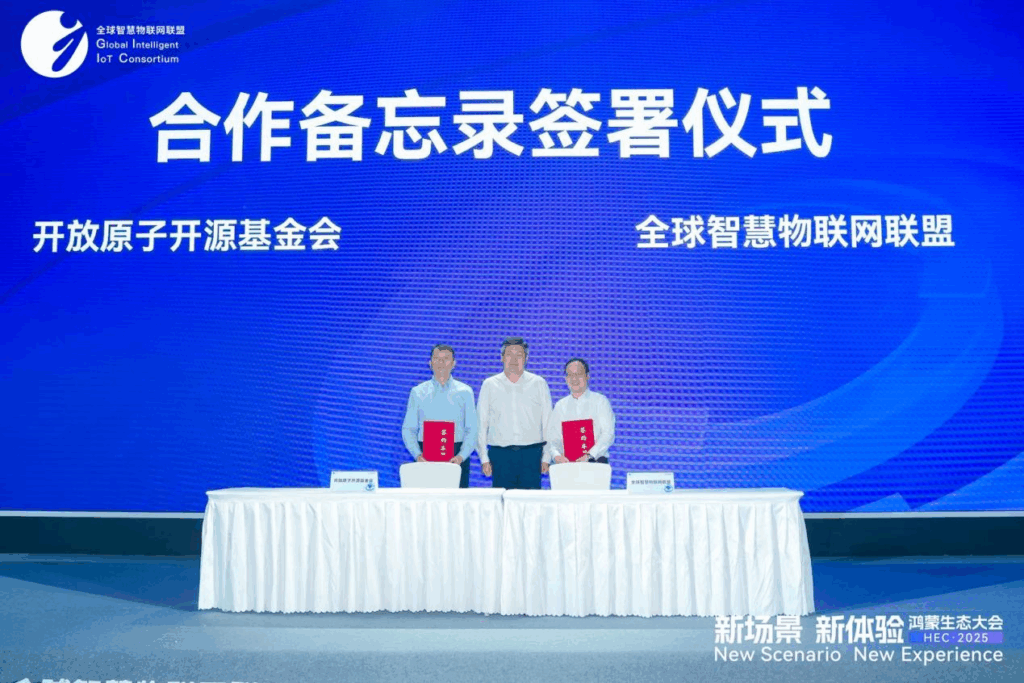
As the conference agenda progressed, the signing ceremony of the Memorandum of Understanding (MoU) was held on site. Under the witness of Wang Weiwei, Deputy Director of the Information Technology Development Department of the Ministry of Industry and Information Technology, Cheng Xiaoming, Chairman and Secretary-General of the OpenAtom Foundation, and Hu Caiyong, Secretary-General of the Global Intelligent IoT Alliance (GIIC), signed the MoU first. This handshake marked a historic "handshake" between the ecosystem in the core fields of technical code foundation and industrial ecosystem promotion, promoting a deep leap from "technological open-source" to "ecosystem co-construction." Through coordinated technical standards, industrial resource docking, and implementation of scenario-based solutions, it will break the barriers between technological innovation and industrial application, laying a milestone foundation for the large-scale development of the ecosystem with a dual-wheel drive of "technology + ecosystem."
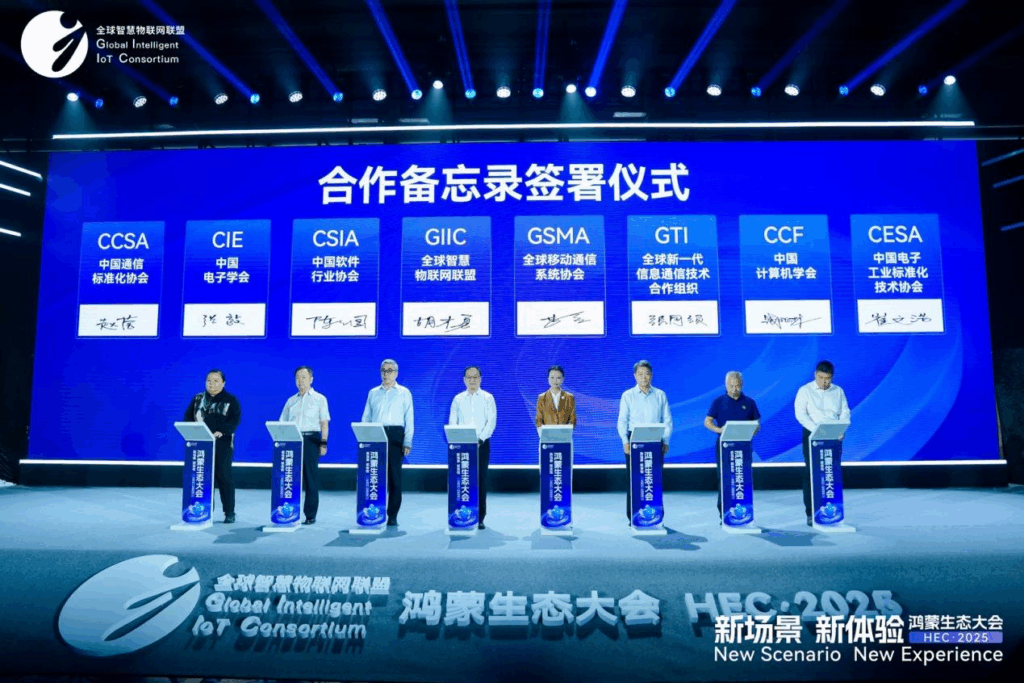
After the signing of the two core organizations, the ceremony welcomed the second round of signings. Global System for Mobile communications Association (GSMA), Global TD-LTE Initiative (GTI), Chinese Institute of Electronics (CIE), Chinese Computer Federation (CCF), China Software Industry Association (CSIA), China Communications Standards Association (CCSA), China Electronics Standardization Association (CESA), and the Global Intelligent IoT Alliance (GIIC) jointly signed the Memorandum of Understanding. Diverse forces from home and abroad gathered, covering international communication standard organizations, domestic authoritative industry associations, and standardization institutions, injecting comprehensive driving forces into the Harmony ecosystem and promoting its standardized development and implementation in a broader field.
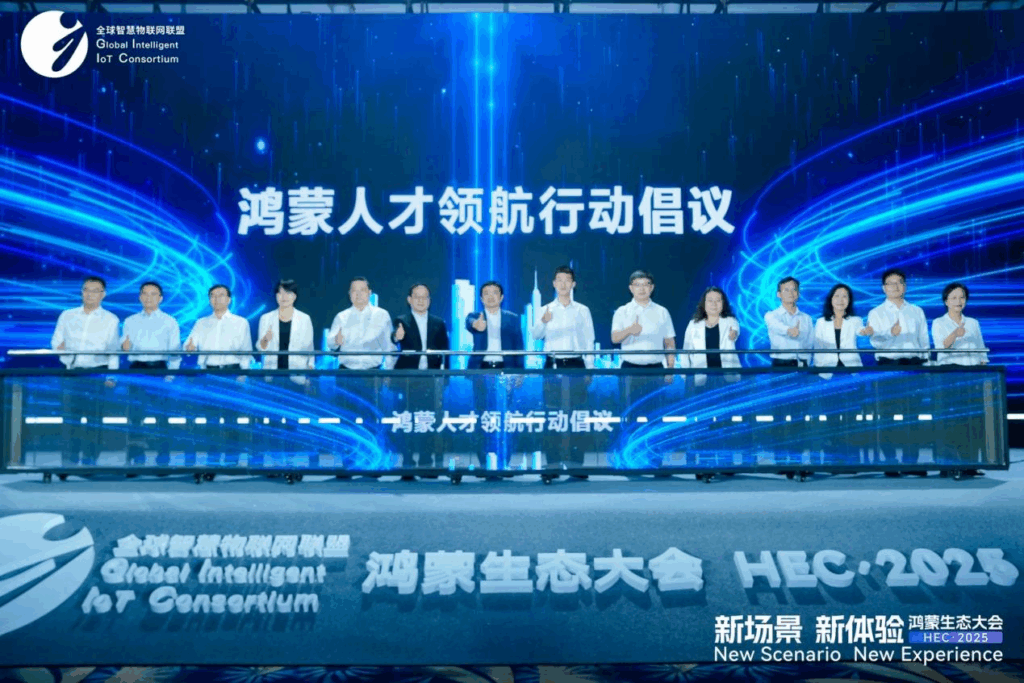
The ceremony also launched the Harmony Talent Leading Action Initiative on site. Initiated jointly by 14 units including the Talent Exchange Center of the Ministry of Industry and Information Technology and the Student Service and Quality Development Center of the Ministry of Education, the action will integrate resources from the government, enterprises, universities, media, and other parties to reserve talents for the Harmony ecosystem from technical research and development to industrial application, providing an "intellectual engine" for the long-term sustainable development of the ecosystem.
Part.4
Industry Sharing: Diverse Practices Showcasing Excellence
The session of industry experts' sharing was exciting and fully demonstrated the diverse practices of the Harmony ecosystem in different fields.
Lu Ji, Director of Tencent Video Frontend Development, shared the construction progress of Tencent Video for Harmony. As one of the top applications of Tencent that have been launched on the Harmony system, it currently has a download volume of over 6 million times. The completeness of its functions is close to 100%, and it performs excellently in core experiences such as smoothness and playback speed. He said that in the future, Tencent Video will continue to cooperate with Huawei and the open-source community to promote the prosperity of the Harmony ecosystem.
Li Chao, Vice President of Panwei Technology, said that since fully embracing the Harmony ecosystem, they have achieved full-end product adaptation to Harmony, covering consistent experiences on iOS, Android, and Harmony. They have completed multiple office applications, including official documents, meetings, and business management, and will continue to help upgrade the efficiency and experience of government and enterprise office work.
Yu Rongrong, General Manager of China Mobile's Smart Home Operation Center, introduced Zhongyi Zhihong OS, which features low resource consumption, high performance, and high security. It can achieve cross-device interconnection and multi-scenario AI service deployment. The "Ten Hundred Thousand Million" action plan was also proposed to promote the landing of over ten chip adaptations, over a hundred terminal applications, and over ten million devices in the next three years.
Shang Zhe, General Manager of Midea Group's Whole House Intelligence, stated that Midea has made the leap from single-item intelligence to whole-house intelligence, launching the "AI Xiao Mei" intelligent entity and the Harmony version of Midea Meiju APP. Currently, there are over 300 Midea products certified for Harmony.
Long Xiaoang, General Manager of Hualong Xunda, shared the industrial neurons based on Harmony and Loongson, achieving full autonomy in industrial control. They have been applied in fields such as aviation, automobiles, and robotics, efficiently realizing automatic program generation and replacement of foreign systems, assisting the independent and intelligent upgrade of industry.
Wan Li, Senior Vice President of Goke Micro, introduced the company's achievements in OpenHarmony chip adaptation, having completed certification for multiple chips applied in education, vision, display, and other fields. He emphasized that in the future, they will continue to promote the integration of Harmony and AI, providing a solid underlying support for the ecosystem.
Dai Di, CIO of Milikea, shared the practice of smart stores based on OpenHarmony. Using the Harmony smart cash register as the computing power center, it realizes intelligent linkage and collaborative management of devices. The Harmony system helps to reconstruct retail relationships and promotes the upgrade of stores to smart living centers.
Zhang Yang, CEO of MUSE AI, shared how his team relies on Harmony's distributed capabilities and intent service framework to achieve seamless cross-device collaboration and scenario-based intelligent recommendations in the AI creation process. He mentioned that the Harmony ecosystem effectively lowers the development threshold, helping MUSE AI efficiently cover multiple terminal scenarios and improve user experience.
Part.5
Achievements Release: Leading New Industry Standards
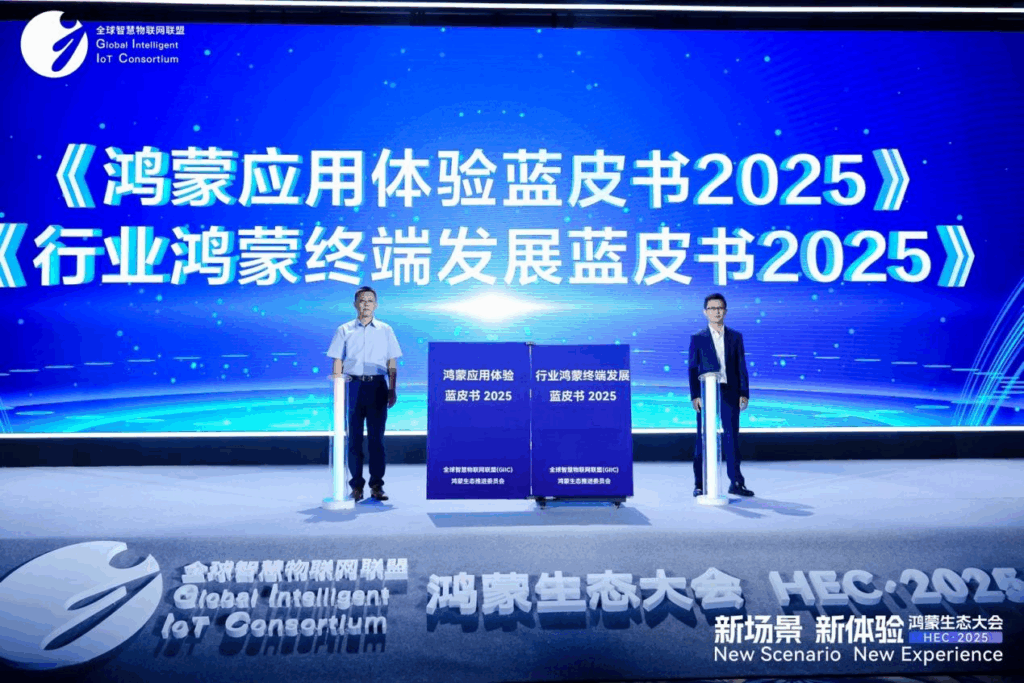
During the conference, the "Harmony Application Experience White Paper 2025" and the "Industry Harmony Terminal Development White Paper 2025" were released. These documents, which condense the forward-looking plans of alliance members and the industry, systematically combing the optimization paths for Harmony application experiences and the innovation trends of industry terminals. They provide clear development guidance for ecosystem partners, marking a steady transition of the Harmony ecosystem from a stage of scale expansion to one of quality improvement.
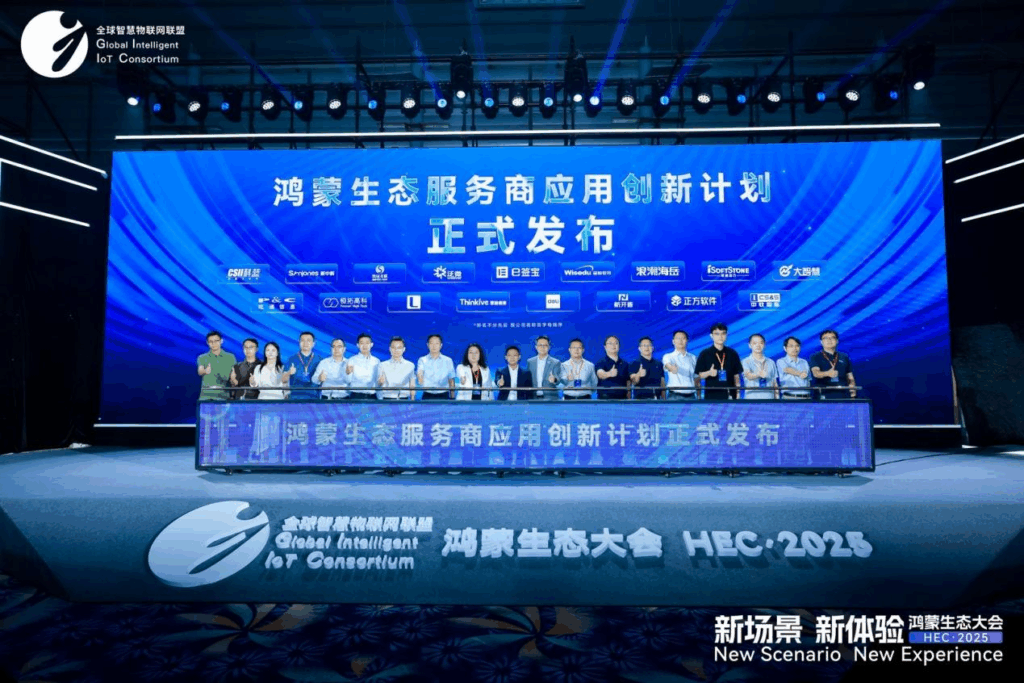
The "Harmony Ecosystem Service Provider Application Innovation Program" was also launched concurrently. Focusing on Harmony ecosystem service providers, it facilitates resource docking and technological empowerment. Leveraging Harmony's distributed capabilities and open philosophy, the program helps service providers break through terminal and scenario boundaries to jointly build consistent, efficient, and intelligent industry solutions.
Additionally, the GIIC Harmony Security Special Committee was officially established, signifying the launch of the world's first professional organization focusing on Harmony security division of labor and integration of Harmony security ecosystem resources. The GIIC Architecture Special Committee was also officially established to assist the vertical architecture industry in achieving Harmony transformation. The first batch of GIIC SDK certification initiation ceremony was held to standardize the development tool chain and improve application quality. The first batch of Harmony ecosystem device unified interconnection certification was also launched simultaneously to unify cross-device communication protocols. The final release was the "Harmony Ecosystem Talent Capability Evaluation Standard: OpenHarmony Device Developer Capability Evaluation Standard" and the "Harmony Ecosystem Device Unified Interconnection 2.0 Series Standards," filling the gap in ecosystem talent capability certification. These series of measures, from industry specialization, standardization, device interconnection to talent cultivation, work on multiple dimensions to consolidate the development foundation of the Harmony ecosystem and accelerate its progress towards the goal of intelligent connectivity of all things.
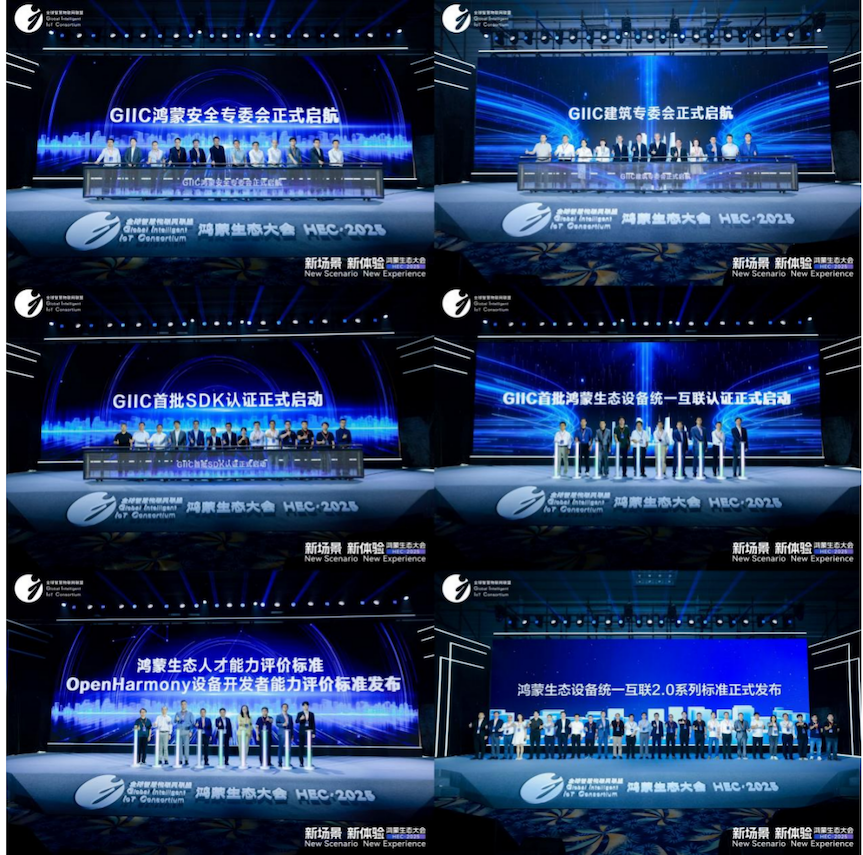
Part.6
Sub-forums and Exhibition Areas: In-depth Communication and Experience
The sub-forums in the afternoon were equally exciting, with a two-day agenda focusing on technological innovation and scenario practice in fields such as intelligent transportation, intelligent communication, intelligent architecture, industrial control, talent development, and Harmony ecosystem partner SDK. The sub-forums provided a platform for in-depth communication and discussion, promoting cross-field idea collisions and collaborative innovation. Here, industry experts, scholars, and corporate representatives could share experiences, exchange ideas, and jointly explore the application and development paths of the Harmony ecosystem in different fields.
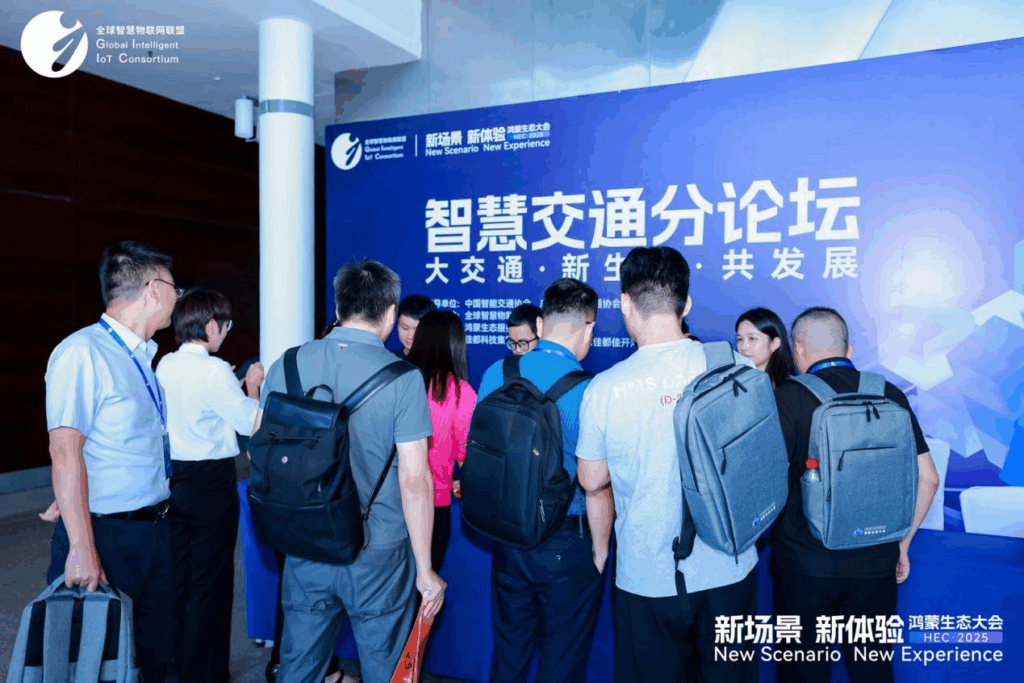
In addition to the main and sub-forums, the Harmony ecosystem exhibition area became the "immersive classroom" of the conference. Through dynamic demonstrations and interactive experiences, the exhibition area fully presented the innovative achievements of Harmony technology in fields such as communication, medical care, finance, industry, education, and home. Participants could personally experience the charm of Harmony technology and intuitively understand the application scenarios and development potential of the Harmony ecosystem. The exhibition area was open to the public on August 31, allowing more people to understand and feel the innovative achievements of Harmony technology, effectively enhancing the social influence of the Harmony ecosystem.
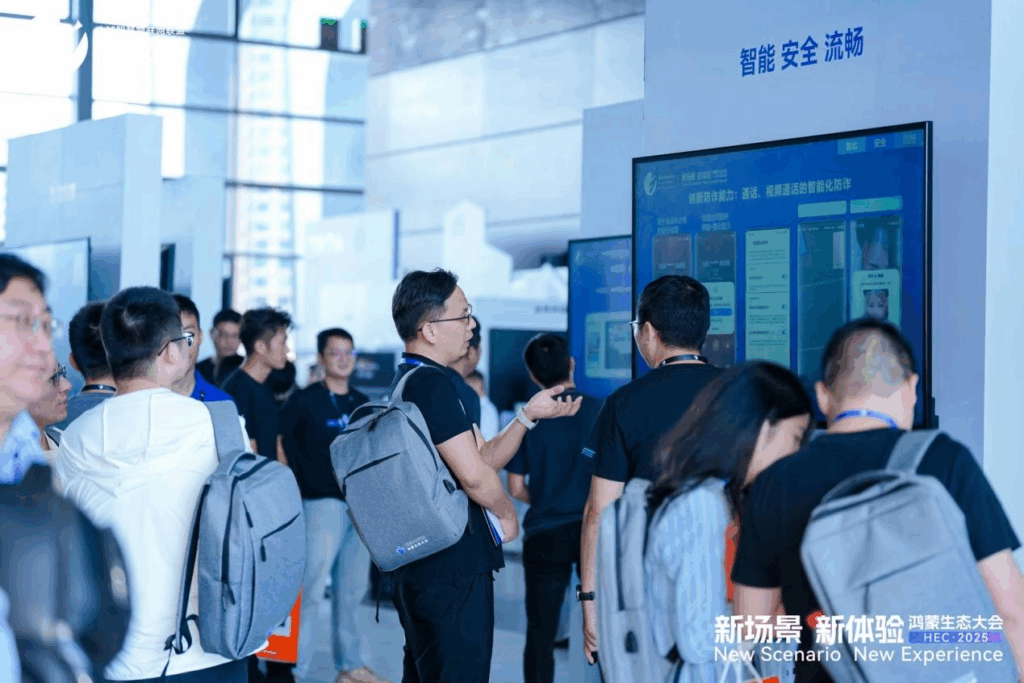
The successful hosting of the Harmony Ecosystem Conference 2025 has injected new vitality into the development of the Harmony ecosystem. From the cutting-edge insights of the main forum to the in-depth discussions of the sub-forums, and then to the intuitive display of the ecosystem exhibition area, the Harmony ecosystem is embracing the world with an open posture and an innovative spirit, jointly opening a new era of intelligent connectivity with global partners. In the future, the Harmony ecosystem will continue to adhere to the core concept of "openness, integration, cooperation, and co-win," strengthen cooperation and exchanges with various industries and fields, and jointly promote technological innovation and development. It can be foreseen that the Harmony ecosystem will bring us more surprises and changes, and together witness the great power of technology to change the world.